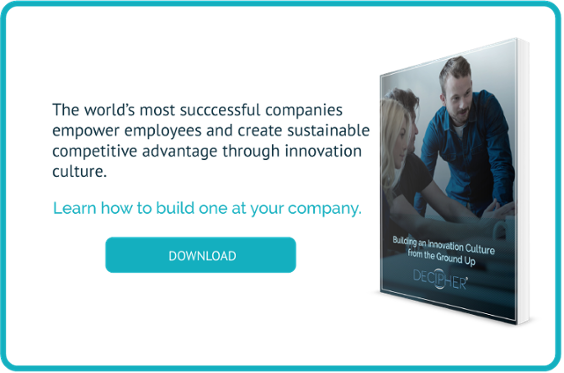
Unless you’re cultivating a true innovation culture that emphasizes and encourages forward thinking and new ideas, you won’t be able to reap the benefits: positioning your business as an industry leader and attracting & retaining customers ahead of your competitors. In other words, hiring for innovation is good for your bottom line. Here are the first few steps and considerations to make when building that team:
Step 1: Define Your Innovation Strategy
Although you’re building a team, it’s risky to just jump straight to the hiring process, especially if this is your first foray into creating an innovative environment. Before seeking out personnel, make sure that your innovation strategy is clearly laid out before organizing your team. This is usually best tackled by a collection of senior staff members who have a solid understanding of the organization’s mission, and at least some idea of where they’d like to see the company go in terms of financial gain and global impact.
Step 2: Recruitment
When you’re hiring for innovation, you want to get the best minds on your team. It may not be as easy as seeking out “Innovation Directors,” however. Almost anyone can be part of an innovation team, as long as they are filling a specific function and contributing to the development of new ideas. Usually Creative Directors, Product Engineers, Back- or Front-End Developers, and Strategists are a good fit for the team, but also having someone in a customer-facing role will keep everyone grounded and be able to identify if a given idea fits what your customer base is asking for or trending towards.
Skill sets that match your industry and job function are of course important, but the two most powerful characteristics you should seek out in your innovation team candidates are creativity and passion. Michael Gough, VP of Experience Design at Adobe, once said, “When I’m trying to decide how to choose a designer, to hire one over another… I am always going to lean towards the people that could not stop doing [their] work.”* When both creativity and passion are present on your innovation team, you have an implicit assurance that ideas will not only be created, but executed.
Step 3: Setting the Mission
This will be one of the easiest components to determine, since it should align with your organization’s goals for innovation and follow the innovation strategy you developed during step one. The staff you’ve hired should be familiar with the intellectual property development process as a whole, and optimally with the organization's goals, as well. In a collaborative discussion, work with the team to establish a concrete timeline for delivery on their upcoming initiatives. From there, they’ll be able to adjust their process and workflow to best meet expectations.
Step 4: Encourage Education
Your new employees are the experts, but it’s important to establish role redundancy early in the event of attrition; you do not want potential single points of failure that could have broader ripple effects. Once the main goal and timelines have been established, task the innovation team with the mission of setting the foundation for an innovative environment. Assign team members to connect with different departments and advise them on how to best support the innovation team’s goals and, by association, the organization’s goals. In order to minimize communication barriers and knowledge gaps, make your assignments based on common background and skill sets to start.
Step 5: Establish Key Performance Indicators
You don’t make your hiring decisions without a way to verify that the employee is contributing to the growth of the organization as a whole, and hiring for innovation is no exception. Inform the team that their success will be measured based on a few metrics to start, and that they should keep track of this data:
- Number of concepts or inventions proposed
- Number of concepts or inventions built or put to market
- The cost of development for a given invention (time and money)
- The revenue generated after deployment of a given product
On a larger scale, you can also track your organization’s success at following your innovation strategy. Look for things like:
- The size, value, and success of your IP portfolio
- A breakdown of the types of innovations proposed
- Which types of innovations yield the most success
- Trends in development for specific employees or teams
With a list of metrics, you’ll be able to quantify and qualify whether or not you’re adhering to your innovation strategy. Although it can be a lot of data to sort through, especially over time, there are tools available that help companies manage and analyze their IP activity.
Next Steps?
Even with the steps listed above, hiring for innovation and forming a dedicated team to advance your company’s impact on the world can be a difficult plan to execute. In fact, the first step in the process may be the hardest to execute… and you can’t take further action without it. Your innovation strategy will be easier to establish after you know the type of environment you want to ultimately achieve. To get started on building an innovative culture, click here to download the eBook on Building an Innovation Culture from the Ground Up.
*Source: Lynda.com course, “Pitching Projects and Products to Executives”


